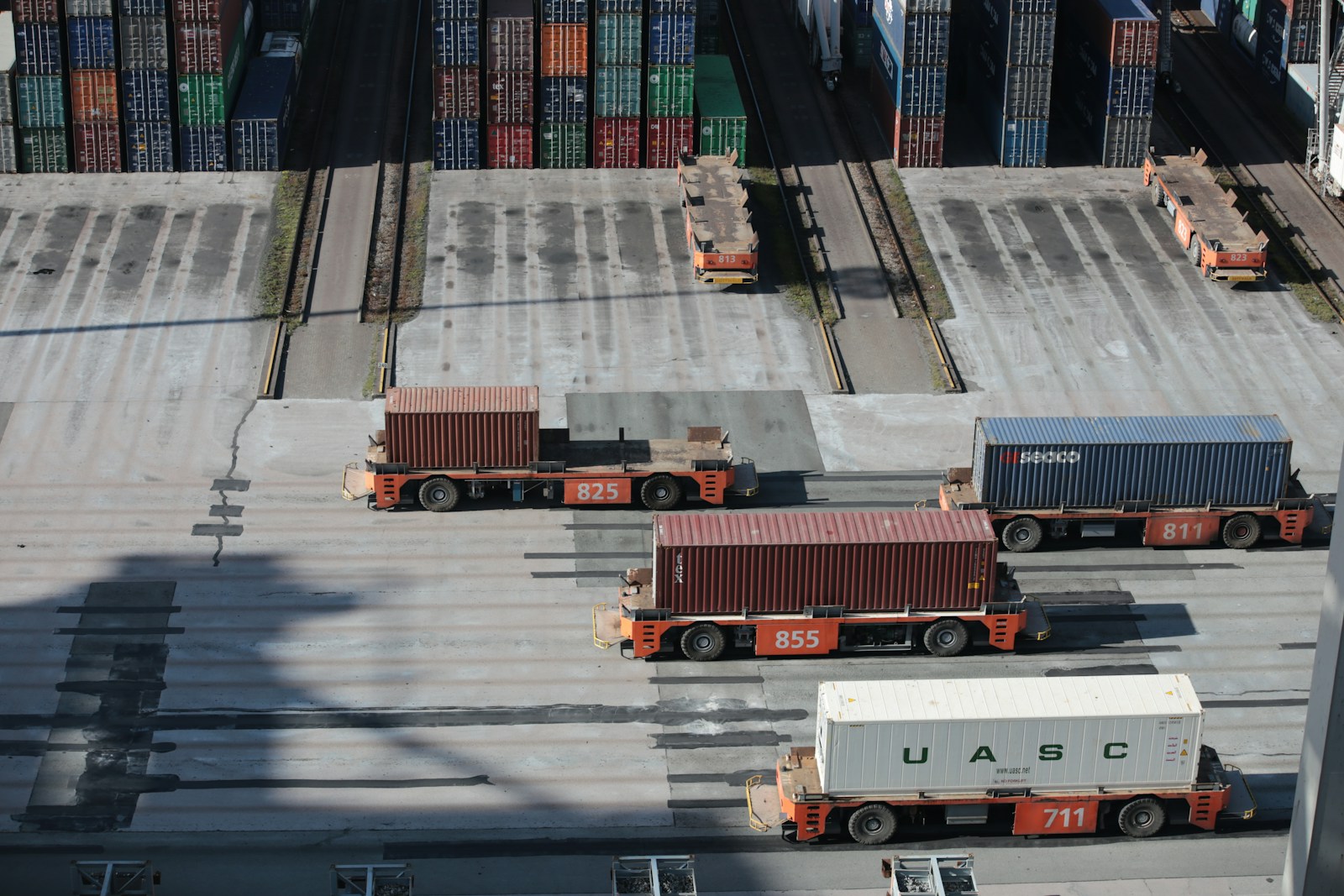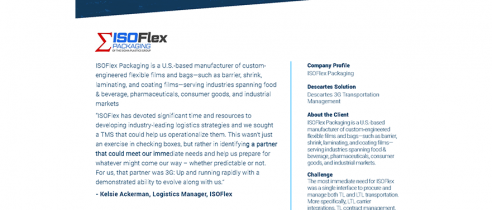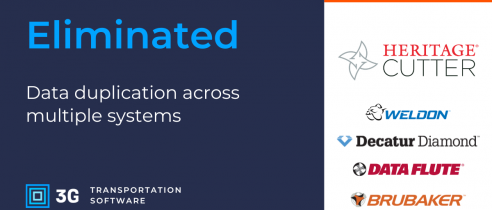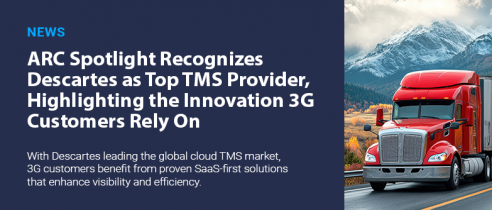Blog
Freight Forwarding Reinvented: Cutting-Edge 3PL Freight Software

The global third-party logistics (3PL) market is expected to reach a whopping $1.3 trillion value by 2026. However, the various challenges thwarting the industry, such as a distinct lack of collaboration, the ever-changing government regulations, no succinct data hubs, and increasing demand for advanced visibility, require a steadfast solution to keep the industry running smoothly.
Enter technological innovations like 3PL freight software, the ticket to a seamless logistics sector that survives the otherwise devastating worldwide digitalization. From improving efficiency to enhancing tracking to offering real-time data in one cohesive platform, this software challenges traditional methods, future-proofing the freight forwarding market.
Businesses that adopt these platforms sooner rather than later can gain a significant competitive advantage.
Evolution of Freight Forwarding
Traditionally, forwarding agents were mediators who planned the transport of goods from point A to point B. They didn’t own equipment or vehicles or have employees.
Time travel to the modern world and freight forwarders play a critical role. They still handle goods transportation, but they also:
- Help process orders when contracted.
- Coordinate the entire shipping process.
- Contact shippers to determine the best routes, considering costs, duration, and product type.
- Work with carriers to prevent delays and ensure safe transportation.
- Offer various value-added services, like customs clearance, packaging, and warehousing.
This industry evolution has birthed the need for businesses to have near-complete control of their supply chains. Historically, companies would send their goods to the forwarder and wait for them to find a carrier — a delay-filled, expensive process. Nowadays, companies of all shapes and sizes find value in forwarders’ services, thanks to the implementation of innovative tech that’s revolutionized previously inefficient processes.
The Role of 3PL Freight Software
The dramatic shift taken by the industry is mainly due to the massive demand for global trade and the e-commerce boom. Freight forwarders now offer end-to-end logistics solutions made possible through 3PL freight software. With many features and functions (explained below), these programs deftly manage and centralize data, offer real-time visibility and tracking, automate processes, boost efficiency, and supply advanced analytics to increase business profits and secure futures.
Features and Functions of 3PL Freight Software
Every 3PL software is a unified logistics management platform. Yet, they all come with various user interfaces, features, and functions.
That said, the applications worth their salt will have the following standard features:
- Auto order allocation — These days, automatic order allocation is necessary for 3PL freight software, not a desire. Its smart (i.e., AI-driven) auto-allocation engine chooses the perfect partner based on the 3PL’s performance, SKU type, payment type, order volume, invoices, and more.
- Route optimization tools — Freight forwarding software allows businesses to meet tight deadlines by planning efficient multi-stop routes. It instantly considers time windows, driver skill, cost, and more to establish the optimal delivery route, saving companies maintenance, labor, and fuel costs.
- Carrier performance monitoring — This feature benchmarks 3PL performance based on common non-delivery reasons, the number of on-time deliveries, and other KPIs.
- Real-time tracking — Dispatchers receive real-time visibility on drivers, giving them unparalleled visibility to establish ETAs, locations, and shipment statuses.
- Automatic label generation — Gone are the days of manual label creation and printing. Intelligent 3PL freight software generates labels in the standardized format using the order information from the LSP. This isn’t just convenient for the forwarder but also for the sender and carrier.
- Returns management — Advanced freight forwarding software automates returns management, improving customer experience and completion times. It instantly assigns the pickup driver while detailing the most efficient route for the job.
- NDR management — Common non-delivery reasons are sorted into different categories, ensuring businesses can quickly gauge NDRs to relieve pain points.
Addressing Freight Forwarding’s Common Challenges
Freight forwarders face many challenges; with great power comes great responsibility, and while some innate struggles are out of their control, advanced 3PL software can prevent or solve many, such as:
- Rising consumer visibility expectations — E-commerce giants have ensured people expect low-cost, lightning-fast shipping with almost to-the-minute tracking. Consumers are savvier than ever before, with many craving the real-time tracking enterprises like Amazon provide. The standard (set, as always, by massive corporations) causes many freight forwarding companies to incur significant costs. Yet, it’s worthwhile, as 81% of shippers note that visibility is crucial to their freight forwarder evaluations. Luckily, such agencies can achieve the real-time data dream by providing clients with a centralized data hub through 3PL software.
- Customs-related delays — Procedural and human errors are the main reasons behind customs delays. However, delays can be avoided altogether with advanced freight forwarding software and process automation.
- Law and regulations changes — Since logistics plays a huge role in the economy, it’s a popular topic among lawmakers and politicians, provoking near-immediate adjustments and responses from freight forwarders and others in the industry. The software can help said businesses stay aligned with the latest changes, as they’re regularly updated when news releases.
- Miscommunication — Delayed communication and misinformation cost freight forwarders their clients. The industry is chaotic, but not enough for customers to provide too much sympathy if communication is lax. 3PL software can act as a central communication channel for internal teams and external clients, cutting down on unnecessary phone calls without losing the human aspect of the business.
Benefits of 3PL Freight Software
Aside from alleviating the above challenges, freight forwarding software provides myriad benefits to those who adopt it. New users can expect improved efficiency, enhanced visibility and tracking, and real-time data insights.
Improved Efficiency
Freight forwarding software is a holistic efficiency improver at its core. It’s a game changer for industry participants, regardless of business size, covering everything from LTL coordination and dispatch to label generation and beyond.
Its three-pronged approach tackles freight forwarders’ operations from the below-listed angles to afford efficiency and productivity enhancements across the board:
- LTL coordination — Without 3PL freight software, forwarders struggle to meet the ever-increasing demands of their clients. As e-commerce continues blossoming, the need to move the supply chain along quickly becomes more crucial than today. Thus, adopting technological innovations ensures that companies can keep up.
- Integration — Sometimes, goods must travel through the air, on the water, and via roads to reach their destination. Freight forwarding systems let businesses coordinate all travel types in one user-friendly application.
- Shipping route optimization — 3PL freight software helps manufacturers find the shipping container traveling the shortest distance between the factory and its destination. On the forwarder’s side, automatic route allocation saves time and money for unparalleled efficiency.
Enhanced Visibility and Shipment Tracking
Quality 3PL forwarding software provides real-time shipment information, including the exact location of goods, at any time. Whether working remotely or in the office, the platform offers a one-stop shop for all visibility and inventory tracking needs. It increases customer satisfaction by preventing delays before they occur and notifying companies about their packages.
Businesses are only going to demand increasingly accurate tracking and order visibility. But by implementing the technology now, freight forwarders can stay ahead of the curve.
Real-Time Data Insights for Informed Decision-Making
Regardless of the industry, data is integral for good decisions. While everyone “gets lucky” sometimes, successful companies are built upon a strong foundation of accurate, holistic data. And that is precisely what 3PL freight software supplies.
Upon system integration, freight forwarding platforms aggregate all necessary information, compiling advanced analytics reports to ensure owners and managers are fully informed about every aspect of the business. With easily accessible, accurate data, decisions boost profits and add actual value to the enterprise.
Freight Forwarding Statistics
The worldwide freight forwarding market is expected to exhibit a Compound Annual Growth Rate (CAGR) of 4% between now (2023) and 2032 as businesses continue extending their international reach. Industrialization and rapid growth among sectors commonly using freight forwarders present compelling expansion opportunities, but only if companies can hop aboard the 3PL freight software longevity train.
As the industry explodes, the only way to remain atop the chaos is by implementing a scalable, technological solution that can effortlessly cope with boosted capacities, evolving needs, and broadening horizons.
Key Global Freight Movement Statistics
With numbers at the forefront, moving to digital, automated processes is a wise decision for freight forwarders. Just a quick look at the current major global statistics proves the figures speak for themselves:
- The digital freight forward market started at $2.92 billion in 2020 and is set to reach $22.9 billion in 2030, accounting for 8% of the overall market.
- In a McKinsey survey, 90% of supply chain leaders reported buying digital supply chain management technology since 2021.
- The same study stated that 80% expected to continue investing in digital solutions to future-proof their companies.
Current Industry Trends
But what’s triggered these staggering statistics? Experts say it’s the following industry trends:
- The global expansion of e-commerce
- Boosted competition in the space
- Increased demand for visibility and granular tracking
- The hike in Free Trade Agreements (FTA) and global trade deals
- Higher logistics costs encourage a digital transformation.
- AI- and ML-backed process automation
- Cloud-based all-in-one solutions (like 3PL freight software)
Selecting the Ideal 3PL Freight Software
Since the entire industry’s digitalization, plenty of 3PL freight software has appeared on the market, giving forwarders tons to choose from. But so many choices can be overwhelming, making it nearly impossible for companies to select the perfect one for them without a helping hand.
To purchase the best platform, business owners must understand their requirements. A solution only works as intended if it genuinely resolves current pain points and prevents future ones.
Once the needs are established, companies can move on to the following ten considerations:
10 Factors to Consider
#1 Advanced Technology
As mentioned earlier, advanced technology is a must-have when picking software. The freight forwarding tech world moves quickly, so buying outdated products will limit opportunities and decrease the likelihood of remaining profitable.
This is the most critical factor, drastically altering the platform’s performance. Plus, it saves precious dollars in the long run and prevents automation errors.
#2 Scalability
Businesses change and expand constantly, but due to the typically slow(ish) order increase, some companies only realize they’ve grown considerably once they’re struggling to meet clients’ demands. Things that seemed easy before feel arduous and time-consuming. As such, any 3PL freight software must boast excellent scalability. Throwing money at a platform that won’t be able to keep up with capacity two years from now isn’t the most intelligent entrepreneurial decision.
#3 Packaging and Labeling Standards
Adhering to specific regulations around product packaging and labeling is crucial in the freight forwarding sphere. The ideal 3PL software will offer invaluable compliance measures, expertly averting possible complications. It eliminates the complications of aligning with the always-evolving industry regulations.
#4 Integration with Current Systems
Some 3PL freight software integrates with existing systems better than others — several are even unable to work with services provided by other brands. However, seamless system integration guarantees data synchronization, eliminating the need for manual data entry and the necessity for heavily customized utilities. Thus, considering whether the particular model can work synergistically with in-place systems is necessary before splashing cash.
#5 Ease of Use
Well-designed user interfaces and responsive navigation raise the likelihood of successful adoption and the platform’s efficiency within the organization.
However, ease of use extends beyond design and ongoing support and training. Thankfully, 3PL freight software developers understand the need for vendor training to help their customers effectively use the platform, ensuring most providers are of this service.
#6 Reporting and Billing
Managing billings and receivables efficiently is one of the most essential parts of running a business, especially in the logistics industry. As such, it’s also one of the most integral elements of 3PL freight software. Opt for a solution that automates storage, put-away, receiving, and shipping tasks. Instantaneous processes guarantee accurate, timely invoicing for said services.
#7 Vendor Reputation
Nothing beats research when it comes to finding the perfect freight forwarding software. Unhappy (or incredibly happy) customers are always willing to share their opinions online. So, always research platform providers before buying into their offerings. A vendor with a strong reputation and a history of optimal implementations will provide high-quality software with desirable customer service.
#8 Cost
Contrary to widespread belief, “cost” is more than the original price. Just because something is expensive doesn’t mean it’s good. Just because something is cheap doesn’t mean it’s awful. And vice versa.
So, companies should move beyond considering the raw price to evaluating the value of each offer, alongside remaining vigilant about any hidden costs or extra fees that could occur during customization or implementation.
In other words, freight forwarders must establish the overall ROI to guarantee that the solution provides the long-term value they’re hoping for.
#9 Support for Multiple Accounts
Generally speaking, more than one person or entity needs to access information held on the 3PL freight software. Depending on the company’s size, each department requires real-time access to store data. Great platforms offer multiple user accounts to ensure numerous people can log in simultaneously, improving employee collaboration and efficiency.
#10 Customer Service
Everybody, freight forwarders included, forgets the value of quality customer service until they need it. And that’s only natural. However, considering the efficacy of the provided support before buying the software is essential. Why? Because by the time it’s required, it’s far too late.
There should be enough support options available to help at all times, including live chat, FAQs, video tutorials, phone numbers, and email addresses for key personnel.
Implementation and Integration
While definitive implementation and integration steps depend on the specific 3PL freight software purchased, a few tried-and-tested universal strategies for ensuring success and seamlessness are outlined below.
4 Steps for Seamless Implementation
- Set baselines and objectives — Successful deployment rests on a solid foundation. Companies should outline how they want their processes to look after implementation and work backward. That way, they’ll be able to pick the best 3PL freight software without wondering whether it’ll fit their needs down the line.
- Embrace the change process — Humans are hard-wired to resent change. But as the adage says, it’s the only constant. Managers should help employees embrace the transition process to ensure smooth implementation.
- Communicate effectively — Similarly, rolling out freight forwarding software shouldn’t involve only a few employees. Everybody needs to be involved to increase the likelihood of happy adoption.
- Invest in training — Regardless of how user-friendly a solution is, companies must provide employees with adequate training to be influential users.
Best Practices for Successful Integration
Implementation should be conducted alongside integration, which comes with a few best practices, such as:
- Ensuring all technology is supported by current systems.
- Selecting a great internal project manager to guarantee the steps mentioned above (and those listed here) are conducted.
- Communicating the value of the new platform to shareholders.
- Listening to employee feedback to establish improvement areas.
Security and Compliance Considerations
Data security and regulatory compliance are vital areas of consideration in logistics. From the labels on the shipments to how customer data is stored, policymakers go through the industry with a fine-toothed comb, ensuring domestic shipping companies are doing their best.
Thankfully, modern technology has given trucking and freight forwarders a relatively easy way to ensure they stay within the rules.
Ensuring Data Security in Freight Operations
Today’s 3PL freight broker software takes data security very seriously, providing many features that protect users’ information, such as:
- A centralized, cloud-based data storage.
- Strict document access protocols.
- End-to-end encryption.
- API integration for secure, seamless data transfers.
- Secure access to protect against breaches.
- Always-updated security policies.
Guaranteeing Compliance with Industry Regulations
Compliance ensures that all shipments meet regulatory and legal requirements set by industry organizations, national governments, and international entities. The freight shipping world is a complex, multi-faceted part of the industry, encompassing a vast range of standards that must be met to guarantee the safe and secure transportation of goods.
The three main concerns are Customs documents, packaging, and labeling, but 3PL freight forwarding software automates it all, keeping companies safe from costly penalties for failing to comply.
Future Trends in 3PL Freight Software
The future is largely unknown, but the emerging technologies and predicted industry developments give freight forwarders a rare look into the sector’s anticipated tomorrow.
Predicted Sector Developments
As time progresses, experts suggest well-curated data will define the difference between companies making it in the industry and those not, citing a survey in which 48% of respondents noted that data will improve visibility into assets over the coming three years.
The same survey mentions that 44% believe data will improve customer relationship management, and 35% consider it to enhance workforce optimization.
Moreover, 87% of freight forwarders have noticed that more shippers emphasize technology solutions during their evaluation processes. Unsurprisingly, so many forwarders are already turning toward advanced 3PL freight software.
Integration with Emerging Technologies
With technology at the forefront, it’s worth noting the emerging technologies that the best freight forwarding software will integrate/have integrated:
- IoT devices
- Automation backed by machine learning and artificial intelligence
- Tailored solutions
- Drones and other autonomous vehicles
- Blockchain technology
Most emerging technologies can be seen in other professional and personal environments. So, companies should expect the advancements to come thick and fast as the calendar flips to 2024.
3PL Freight Software Success Stories
Cloud-based 3PL freight software has a track record of delivering exceptional results for forwarders and other businesses. Google, Amazon, and Walmart have implemented the solutions and found global success. However, even smaller companies have benefitted, with many saying they’ve reduced associated costs, boosted efficiencies, and were able to pick up the new working method in just ten to 20 hours.
The Bottom Line
Freight forwarding software brings enhanced visibility and tracking, real-time data for informed decision-making, and improved efficiency to companies that adopt the technology. So, why wait? Providers have much to gain and little to lose by going digital with an advanced 3PL freight platform.







